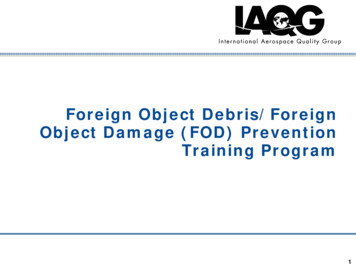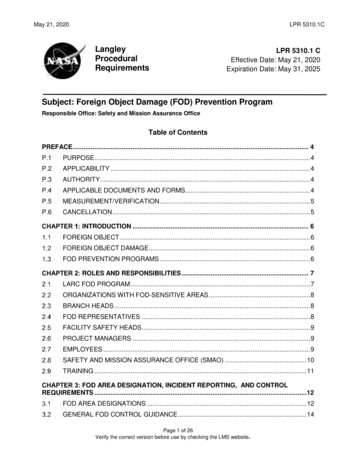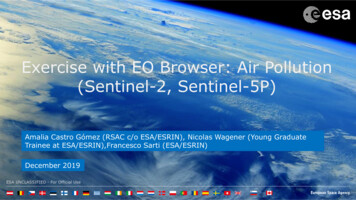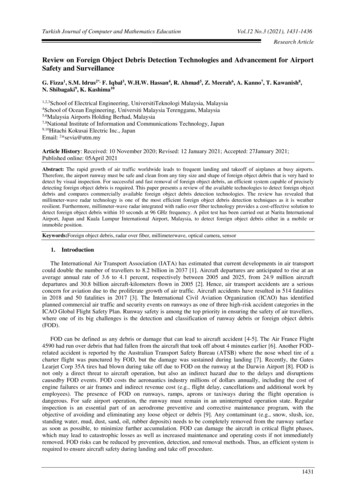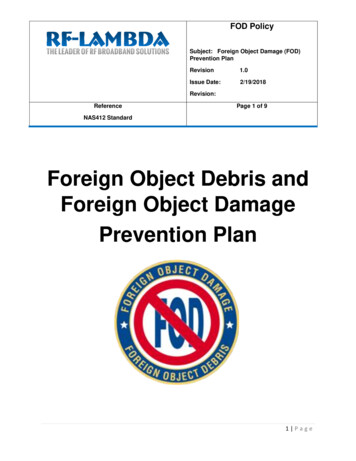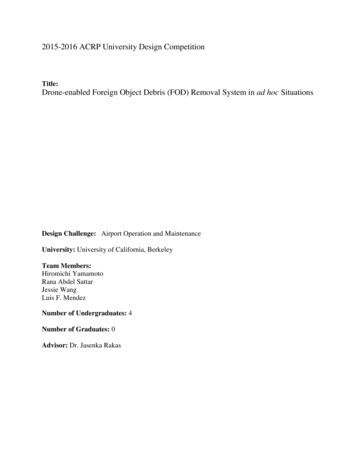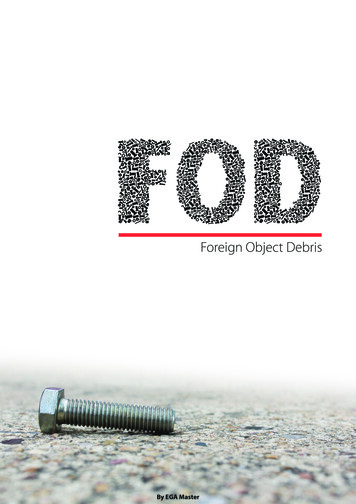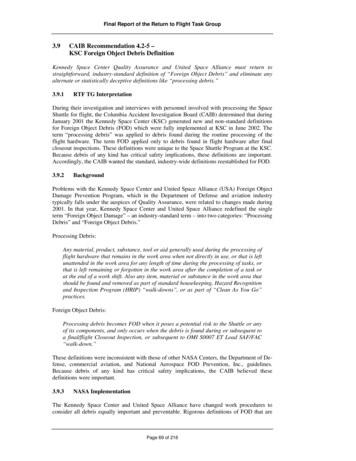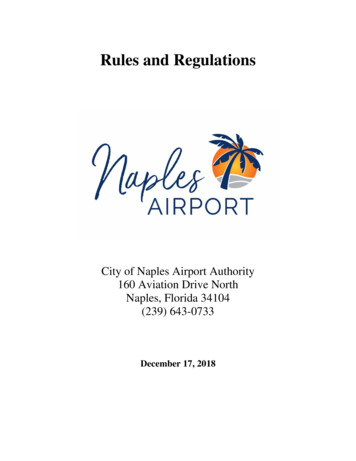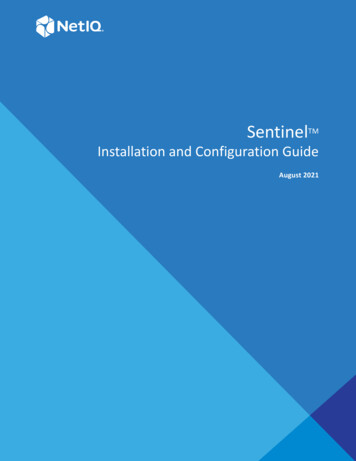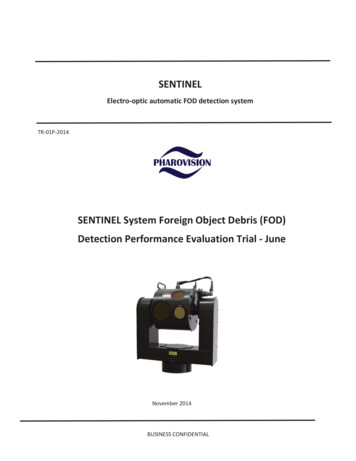
Transcription
SENTINELElectro-optic automatic FOD detection systemTR-01P-2014SENTINEL System Foreign Object Debris (FOD)Detection Performance Evaluation Trial - JuneNovember 2014BUSINESS CONFIDENTIAL
SENTINEL FOD Detection Performance Evaluation Trial June 2014TR-01-2014DISCLAMERNeither person in PHAROVISION LLC nor any employee, or consultant undertakes responsibility toany person or organization in respect of information set out in this report, including any errors oromissions therein, arising through negligence or otherwise however caused.Author: Clélio LeiteteSigned:Date: 28/10/20144Reviewer: Yuval MiloSigned:Date: 11/11/2014Approved by: Dr. Nicholas B. CarterSigned:Date: 11/11/2014BUSINESS CONFIDENTIAL2
SENTINEL FOD Detection Performance Evaluation Trial June 2014TR-01-2014BUSINESS CONFIDENTIAL3
SENTINEL FOD Detection Performance Evaluation Trial June 2014TR-01-2014EXECUTIVE SUMMARYPHAROVISON conducted a trial of the SENTINEL ground-based electro-optic automatic bird detectionsystem in mid June 2014 at an Israel Defense Force Air Base with the objective to evaluate thesystem’s detection performance, as well its functionalities, in order to demonstrate its ability to beused as an effective foreign object debris (FOD) detection system in airport environments. Theexperiment results clearly demonstrate that the SENTINEL in its baseline configuration can be usedto automatically detect most foreign objects in airport surfaces. The detection range of the SENTINELsystem enables the system to be used as ground based electro-optic FOD system during day andnight operations. The system can also meet the FAA requirements described in its Advisory CircularFAA Nº 150/5220-24 in terms of location accuracy, continuous inspection of runways, and responsetime, essential for such types of systems operating in airport environs. It was shown that the systemis capable of detecting small 3 cm x 3 cm FOD targets at a distance of 800 meters with smalltemperature differences between the object and background (ΔT 2oC). The trial demonstrated theadvantages of having both visible (video CCD) and infrared (infrared) imagery of the tarmac surfacessince there are cases in which the system showed better detection of FOD targets with the visualcamera than with the thermal camera (e.g. the detection of small metal foreign objects at smallthermal differences (ΔT 2oC) or the detection of asphalt foreign objects at high tarmac temperatures).It is inferred from this experiment that the fulfillment of all the FAA requirements is technicallyattainable using the current system configuration with modifications, and an entire runway surface(along with adjoining taxiway surfaces within the same range) can be achieved utilizing more thanone SENTINEL sensor head, with optimized spacing between each system, and preferably using highperformance thermal (IR) and CCD video cameras (like the “Long-Range” sensor heads ofPharovision’s portfolio) with spatial resolution to enable FOD identification. To effectively scan the fulllength of a typical runway, the system should be composed of 2 to 4 SENTINEL sensor heads,preferably integrating the sensor data into a single composite image. To be competitive with adedicated FOD system in this case the sensors should not be located more than approximately 400meters from the runway surface (if using the same sensor specifications as the baseline system).Considering the cost of an individual sensor head, the SENTINEL system could be a cost-effectivesolution as a FOD-detection system in airports and even a complete substitute of for other FODdetection systems currently on the market and, depending on the chosen sensor specifications andsystem architecture, it can surpass the performance level of detection of such systems. Ifuninterrupted scanning is required, an extra pair of IR and CCD cameras could be added to baselineconfiguration of the system in order to allow the identification task to be carried out separately whilemaintaining the continuous scan of airport surfaces.The recommendations of this trial will enable to configure a future trial where a hardwareconfiguration and system architecture will be used in order to fully cover the totality of an runwaysurface, in order to demonstrate that the system can detect and identify the full range of FOD targetslisted in FAA AC Nº 150/5220-24 at the required minimum ranges.BUSINESS CONFIDENTIAL4
SENTINEL FOD Detection Performance Evaluation Trial June 2014TR-01-2014BUSINESS CONFIDENTIAL5
SENTINEL FOD Detection Performance Evaluation Trial June 2014TR-01-2014TABLE OF CONTENTSEXECUTIVE SUMMARY .4TABLE OF CONTENTS .61.INTRODUCTION .72.THE EXPERIMENT .103.RESULTS AND CONCLUSIONS .174.RECOMMENDATIONS .22BUSINESS CONFIDENTIAL6
SENTINEL FOD Detection Performance Evaluation Trial June 2014TR-01-20141. BACKGROUNDThe PHAROVISION SENTINEL bird detection system has been designed primarily to automaticallydetect individual birds and flocks of birds, day or night, using a ground–based infrared and electrooptical scanning payload and advanced proprietary image-processing algorithms. This capabilityallows the SENTINEL system to support two critical efforts: the monitoring of bird movements insupport of wildlife management programs and the surveillance of airspace to identify potential threatsto the safe operation of aircraft through the mitigation of the risk of bird strikes within the ControlTower Region (CTR) of the airport.In addition to the bird detection capability, SENTINEL’s ability to detect foreign object debris (FOD)on airport surfaces, namely on runways or taxiways, have drawn a great deal of interest by potentialusers including a large number of airport operators. Upon initial review, the benefit of the SENTINELsystem as a FOD-detection system in comparison with dedicated FOD detection systems is twofold:(1) it can be used for multiple functions – from bird detection to mitigate the risk of bird strikes withaircraft, through security roles, to FOD detection on the runways and other tarmac surfaces, and; (2)the overall cost of multiple SENTINEL systems is considerably lower than any singular dedicated FODsystem. This means that the SENTINEL can be a cost-effective solution as FOD-detection system inthe airports and even a complete substitute of such systems, provided that it can achieve the samedetection performance level of such systems. The system had demonstrated in the past its generalcapability to detect FOD on the runways but no formal tests or trials had been conducted to assessits performance detection of typical FOD targets like those delineated in the FAA AC Nº 150/5220-24(related to the requirements of minimum performance of FOD-detection systems).In order to do a complete assessment of a FOD-detection system capability to operate in the airportenvironment and in accordance with FAA guidance and recommended specifications for procurementof such systems by airport operators, a final overall assessment should be carried out in order toevaluate not only the system’s ability to detect typical FOD objects in terms of material, shape andsizes, but also the system’s ability to conduct automated, continuous search of tarmac surfaces anddetection of typical FOD, day and night in all type of weather conditions, on runways and other aircraftmovement areas.1. INTRODUCTIONThe author conducted a trial in controlled conditions at an Israel Defense Force airbase in the centralcoastal region of Israel in mid June 2014 in order to evaluate the performance of the SENTINELsystem operating as a stationary electro-optical FOD-detection system in the typical airportenvironment. For that purpose an SENTINEL system (in its baseline configuration) consisting of oneBUSINESS CONFIDENTIAL7
SENTINEL FOD Detection Performance Evaluation Trial June 2014TR-01-2014sensor unit (consisting of a thermal camera, CCD video camera and a laser range finder – seespecifications in annex A) was installed at the base of an air traffic control tower and on a towerlocated near runway surfaces.The trial objective consisted not only in performing an assessment of the system’s ability toautomatically detect and identify typical FOD objects at several ranges but also in the assessment ofthe system’s compliance with general minimum requirements delineated FAA AC Nº 150/5220-24.Furthermore, the results of this trial can be used in the future to modify the SENTINEL system baselineconfiguration (infrared detector specification, addition of sensor heads in the complete architectureof the system, and number and spacing of sensor units).The FAA requires that a stationary electro-optical detection system must be able to detect a 0.80 in.(2.0 cm) object target, at ranges of up to 985 ft (300. m) using only ambient lighting. The sensorsmust be located 490 ft (150 m) or more from the runway centerline. Generally, five to eight sensorsare required per runway, depending on airport requirements and runway specifications.Specifically the SENTINEL was tested in order to access its ability to perform the following baselineminimal requirements in the above-mentioned FAA AC:a. Basic Functions.(1) Provide surveillance in the aircraft operating area (AOA) as specified by the airport.(2) Detect and locate single and multiple FOD items on the AOA.(3) Provide an alert to the user when FOD has been detected.(4) Operate in conjunction with, and not interfere with, airport and aircraft communication,navigation, and surveillance systems.(5) Operate in conjunction with, and without interference from, normal airport and aircraftoperations (e.g., aircraft and vehicle movements).(6) Provide a data record of detected FOD, allowing for equipment calibration andmaintenance, and for analysis of the FOD event.b. Detection Performance.(1) Object Detection. FOD detection systems must be able to detect the following objects:(a) Two, unpainted, aluminum squares each measuring 3 cm by 3 cm and 10 cm by 10cm,(b) Two rubber squares each measuring 3 cm by 3 cm and 10 by 10 cm,(c) Two asphalt squares each measuring 3 cm by 3 cm and 10 by 10 cm.(d) Any two of the objects above, located no more than 10 ft (3 m) apart from each other,identified as separate objects.BUSINESS CONFIDENTIAL8
SENTINEL FOD Detection Performance Evaluation Trial June 2014TR-01-2014(2) Location Accuracy. FOD detection systems must provide location information for a detected objectthat is within 5.0 m of the actual FOD object location(3) Inspection Frequency(a) Continuous Detection System. The systems must provide continuous operation from fixedsensors to allow for the continuous inspection of runway surfaces during flight operations.The duration of flight operations is dependent on the airport and specified by the user.(4) Detection Response Time. FOD detection systems must have the capability to provide rapiddetection of a FOD occurrence in the area being scanned.(a) For continuously operating FOD detection systems that are designed to provide betweenmovement alerts, the system must provide inspection of runway surfaces between aircraftmovements.(b) For other continuously operating FOD detection systems, the system must provideinspection updates as specified by the airport, generally within 4 minutes of a FOD occurrence.(5) Surveillance Area. The airport operator will specify the desired surveillance (detection) area in theAOA requiring FOD detection. This area is generally based on the airport’s FOD management plan.The primary area of coverage is the runway (certain portions of the runway may be specified by theairport operator if full coverage is not feasible). Other areas are of lesser importance, with adecreasing level of priority from other paved movement areas down to non-paved, non-movementareas. The manufacturer of a FOD-detection system must notify the airport operator of any locationswithin the specified surveillance area where detection would not be possible.(6) Performance in Weather. FOD-detection systems must demonstrate the detection performanceunder both clear and inclement weather conditions. Under clear weather conditions, the pavement ofthe AOA is expected to be dry, while under inclement weather conditions the pavement will be wetwith rain, snow, or mixed precipitation.(a) Detect objects under rainfall or snow conditions (e.g. having a specific intensity, duration,and frequency) for a two-year category of storm in the local region (as specified in CLIM 20,Climatology of the United States No. 20). More stringent requirements may be specified by theuser.(b) FOD-detection systems must have site-specific performance specifications that include:(i) performance during clear weather conditions;(ii) performance during inclement weather conditions; and(iii) provide the user with the amount of time required for the system to recover aftera rain or snow storm, that is, to return the performance capabilities of clear weatherconditions after adverse weather conditions subside. In this case, the end of adverseweather conditions will be defined as when precipitation of rain or snow ends.BUSINESS CONFIDENTIAL9
SENTINEL FOD Detection Performance Evaluation Trial June 2014TR-01-2014(c) Lighting conditions. All systems must demonstrate detection performance during daylight,nighttime, and dawn/dusk operations.(7) Alerts and Alarms. FOD-detection systems must be able to alert the system operator to thepresence of FOD in scanned areas. The alert must provide airport management with enoughinformation to assess the severity of the hazard in order to determine if immediate object removal isnecessary.(a) False alarms (an alert causing the airport operator to take action to remove a FOD objectthat does not exist) should be minimized and must not exceed:(i) one per day as averaged over any 90-day period, for FOD-detection systems withvisual detection capabilities, or(ii) three per day as averaged over any 90-day period, for FOD detection systemswithout visual detection capabilities. Note: Wildlife may move, or small items may beblown away, before airport operators using these detection systems have a chance toinvestigate FOD alerts.2. THE EXPERIMENTIn order to access the FOD detection performance capability of the SENTINEL system, the followingFOD objects were used as targets that met and exceeded the FAA-mandated requirements:(a) Target type A - Two, unpainted, aluminum squares each measuring 3 cm by 3 cm and 10cm by 10cm,(b) Target type B -Two rubber squares each measuring 3 cm by 3 cm and 10 by 10 cm,(c) Target type C –Two asphalt squares each measuring 3 cm by 3 cm and 10 cm by 10 cm,(d) Any two of the objects above, located no more than 10 ft (3 m) apart from each other,identified as separate objects.(e) Target type D – A metallic screw 3 cm by 1,5 cm.The temperatures of the tarmac and targets were measured for each run during the trial.Meteorological data (air temperature, relative humidity) were collected by the airbase meteorologicalstation. The tarmac and target temperatures was measured using a calibrated APPA 90 Series IIMultimeter.Verification of the detection of objects was conducted at slant ranges of 800m and 1500m.Measurements were conducted using dry and wet tarmac conditions. For that purpose the tarmacsurfaces were pre-wet with water.BUSINESS CONFIDENTIAL10
SENTINEL FOD Detection Performance Evaluation Trial June 2014TR-01-2014In some of the trial runs, the targets were heated to different temperatures using boiled water inorder to get required temperature differences between the FOD experiment targets and thebackground (tarmac).During each run the SENTINEL system was operated in “search mode” using first the IR camera andthen the CCD video camera in order to evaluate the system’s capability to automatically detect theexperiment targets. During each run, after target detection, the system was set to “observationmode”, zooming in on the detected targets alternatively with the IR camera and CCD video camerain order to confirm the classification of targets as FOD and to identify the targets.The precise object target location on the runway was obtained using the “Multi-Spider” display withGIS (Geographic Information System) overlay where the detected targets are superimposed on theairfield map. The coordinate position of latitude, longitude, distance and azimuth (from the sensorhead) are automatically displayed on the system.BUSINESS CONFIDENTIAL11
SENTINEL FOD Detection Performance Evaluation Trial June 2014TR-01-2014LaserRangeFinderMid Wave InfraredThermal CameraCCD VideoCamera2-axes GimbalFigure 1. System Sensor HeadSystem parametersCamera parametersThe INTERCEPTOR EO/IR sensor subsysystem configuration used during the experimentcorresponded to the INTERCEPTOR baseline configuration as follows:xxA MWIR camera (FLIR)o640X512 pixel detector, with 15 micron pitcho2.2q - 27q continuous optical zoom lensoNTSC standard video in Observation mode oCamera aperture:oDetector material:oLens material:A daylight camerao1/3" color detectoro0.9q - 13q continuous optical zoom lensoNTSC standard videooCamera aperture:BUSINESS CONFIDENTIAL12
SENTINEL FOD Detection Performance Evaluation Trial June 2014TR-01-2014Inside TowerDisplayControl &DisplayComputerINTERCEPTOR Figure 2. System block diagramFigure 3. Installation of the SENTINEL on a mast during the trialBUSINESS CONFIDENTIAL13
SENTINEL FOD Detection Performance Evaluation Trial June 2014TR-01-2014Figure 4. Control and display unit of the SENTINEL system in the ATC tower.Figure 5. A calibrated APPA 90 Series II Multimeter was used to measure the target object andtarmac temperaturesBUSINESS CONFIDENTIAL14
SENTINEL FOD Detection Performance Evaluation Trial June 2014TR-01-2014Figure 5. Capture of the SENTINEL display during one of the trial runs - A FOD test target of 10 cm x10 cm was automatically detected at reading of: Azimuth 331.11o, Elevation -0.57o, andRange 1740.2 meters. The detected target (blue cross) can be seen on both the GIS display in thelower-right corner with the geographical coordinates (longitude and latitude) of the FOD test target,as well as the real-time visual scan (pink box) in the lower left display. System location is denoted bya light blue square on the GIS display.BUSINESS CONFIDENTIAL15
SENTINEL FOD Detection Performance Evaluation Trial June 2014TR-01-2014Figure 6. Capture of the SENTINEL display. Zoomed view of the FOD test target shown in Figure 2.1to confirm the detected foreign object. The system was unable to identify the target at that range.BUSINESS CONFIDENTIAL16
SENTINEL FOD Detection Performance Evaluation Trial June 2014TR-01-20143. RESULTS AND CONCLUSIONSThe results of the trial are shown in Table 1.In “search mode”, the system was able to consistently and automatically detect 10 cm x 10 cm objecttargets at a distance of 800 meters. The system would automatically present and highlight with agreen box, the foreign object target detected during the automated runway scan. For the smallertargets (3 cm x 3 cm) the detection was carried out by the system operator. The detection of theobject targets was confirmed by zooming in on the target by switching the system to “observationmode”.The system showed a negligible false alarm rate.From the trial runs, the following conclusions regarding the SENTINEL detection performance in itsbaseline configuration can be drawn:(1) The SENTINEL is able to detect small foreign object targets (3cm x 3cm) of different materialstypes that typically constitute FOD at a distance of 800 meters provided that temperaturedifference between the foreign object and background is at least 2oC (ΔT 2oC)(2) The SENTINEL is capable to automatically detect small targets (10 cm x 10 cm) of differentmaterials types that typically constitute FOD at a distance of 800 meters.(3) The use of the visual CCD camera can be advantageous in place of the infrared camera todetect small metal foreign objects at small thermal differences (ΔT 2oC) or in the detection ofasphalt foreign objects at high tarmac temperatures.(4) The infrared sensor had difficulties in detecting asphalt objects against hot tarmac background,even at high temperature differences.The experiment results clearly demonstrate that the SENTINEL system in its baseline configurationcan be used as to automatically detect most foreign objects on airport surfaces. In its currentconfiguration, with a single sensor head, the long detection range of the SENTINEL system enablesthe system to be used as ground-based electro-optic system to automatically detect FOD in all weatherconditions, day and night, within acceptable ranges from the sensor head. Also the trial showed thatthe system, without any modification, is capable of meeting the FAA requirements described in itsAdvisory Circular FAA Nº 150/5220-24in terms of location, accuracy, continuous inspection ofrunways, and response time that are requirements for such type of a system in airports.It is inferred from this experiment that the fulfillment of all the recommended FAA requirements fora single runway surface is technically attainable using a system configuration with more than oneBUSINESS CONFIDENTIAL17
SENTINEL FOD Detection Performance Evaluation Trial June 2014TR-01-2014SENTINEL sensor head, with an optimized spacing between them, and preferably using higherperformance thermal (IR) and CCD video cameras with spatial resolution to enable FOD identification.To effectively scan the full length of a typical runway, the system would likely be composed of 2 to 4SENTINEL sensor heads, preferably integrating the sensor data into a single composite image. To becompetitive with current dedicated FOD systems, the sensors should not be more than approximately400 meters from the runway surface (if using the same sensor specifications as the baseline system).Due to the constraints of the operating environment and local conditions, target detection was onlyaccomplished at 800 meters. Though the system was able to automatically detect the larger targets(10 cm x 10 cm) at this range, it was unable to automatically detect the smaller objects (3 cm x 3cm). Though the system was capable of manually detecting the targets at this range (through userinteraction), it can be inferred that the system should be capable of automatically detecting all targets(including the smaller sized targets – 3 cm x 3 cm) at the recommended range of 400 meters. Evenat this much smaller range, integration of 3 to 5 sensor heads would sufficiently cover a typical runwaysurface (3000 meters).BUSINESS CONFIDENTIAL18
Table 1.TR-01-2014BUSINESS CONFIDENTIALSENTINEL FOD Detection Performance Evaluation Trial June 201419
SENTINEL FOD Detection Performance Evaluation Trial June 2014TR-01-2014Table 2. SENTINEL compliance with FAA AC Nº 150/5220-24Yes/NoBasic FunctionBasic Functions.(1) Provide surveillance in theAOA as specified by theairport.(2) Detect and locate singleand multiple FOD items on theAOA.(3) Provide an alert to the userwhen FOD has been detected.(4) Operate in conjunctionwith, and not interfere with,airport and aircraftcommunication, navigation,and surveillance systems.(5) Operate in conjunctionwith, and without interferencefrom, normal airport andaircraft operations (e.g.,aircraft and vehiclemovements).(6) Provide a data record ofdetected FOD, allowing forequipment calibration andmaintenance, and for analysisof the FOD event.YesObservationsPre-programmed surveillance areascan be pre-defined and usermodifiedYesYes*YesYesYesb. Detection Performance.(1) (a) Two, unpainted,aluminumsquareseach measuring 3 cmby 3 cm and 10 cm by10cm,(1) (b)Tworubbersquareseachmeasuring 3 cm by 3cm and 10 by 10 cm,(c)Twoasphaltsquareseachmeasuring 3 cm by 3cm and 10 by 10 cm.(d) Any two of theobjects above, locatedno more than 10 ft (3m) apart from eachYes*At 800 meters, only the 10X10 cmobject targets were detectedautomatically. The smaller objectswere manually detected. At 400meter range, the system should becapable of detecting the smallerobjects.Yes*Yes*N/AThis test was not able to becompleted during this test andshould be conducted at a futuredate.BUSINESS CONFIDENTIAL20
SENTINEL FOD Detection Performance Evaluation Trial June 2014TR-01-2014other, identifiedseparate objects.as(2) Location Accuracy. FODdetectionsystemsmustprovide location information fora detected object that is within5.0 m of the actual FOD objectlocationYesStrongly advised the system to havethe “Multi-Spider” display with GISoverlay.Yes*The system is either in continuousscan mode or track/identificationmode. Once a target is detected andif the operator wishes to confirm theclassification as FOD with one of thecameras, the system halts thescanning during that period.Yes*The response time depends of thepre-programmed sectors the systemis assigned to scan. For a typicalrunway, the system takes about 18seconds to scan upon initiation if thesystem is only operated for thatpurpose (2 sweeps are necessary inorder to detect changes of thescene). This time is halved betweenall subsequent scans.(3) Inspection Frequency(a)ContinuousSystem.Detection(4) Detection Response Time.FOD detection systems musthave the capability to providerapid detection of a FODoccurrence in the area beingscanned.(a) For continuouslyoperatingFODdetection systems thatare designed to providebetween-movementalerts, the system mustprovide inspection ercontinuously operatingFODdetectionsystems, the systemmustprovideinspection updates asspecifiedbytheairport,generallywithin 4 minutes of aFOD occurrence.YesBUSINESS CONFIDENTIAL21
SENTINEL FOD Detection Performance Evaluation Trial June 2014TR-01-20144. RECOMMENDATIONSThe trial results clearly showed the benefit of having the SENTINEL system in its current baselineconfiguration employed to detect foreign object debris on airport surfaces. Moreover, this trialprovided an important insight in to how the system architecture and configuration can potentially beadjusted or modified for the system to meet all the requirements recommended by FAA for an electrooptic FOD-detection system.Future trials must test the system performance under adverse conditions (e.g. rain, snow, etc.) wherea degradation of the detection range can be expected due to a decrease in atmospheric transmissionor signal-to-noise ratio degradation.BUSINESS CONFIDENTIAL22
In addition to the bird detection capability, SENTINEL's ability to detect foreign object debris (FOD) on airport surfaces, namely on runways or taxiways, have drawn a great deal of interest by potential users including a large number of airport operators. Upon initial review, the benefit of the SENTINEL
